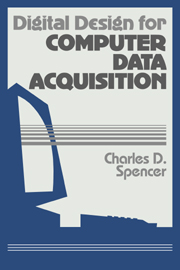Book contents
- Frontmatter
- Contents
- Preface
- 1 Computer Measurement
- 2 Introduction to Digital Electronics
- 3 Parallel I/O Ports
- 4 Tutorial on the AD573 ADC
- 5 Tutorial on the 6264 RAM
- 6 Tutorial on the Intel 8253 PIT
- 7 Control/Data Interface
- 8 ADC Module
- 9 Comprehensive Measurement System
- 10 Fast Voltage Measurer
- Appendix A References
- Appendix B Vendors
- Appendix C IC Pin Assignments
- Appendix D IBM Paralel Ports
- Appendix E Apple II Parallel Ports
- Appendix F Computer Architecture
- Index
7 - Control/Data Interface
Published online by Cambridge University Press: 10 November 2009
- Frontmatter
- Contents
- Preface
- 1 Computer Measurement
- 2 Introduction to Digital Electronics
- 3 Parallel I/O Ports
- 4 Tutorial on the AD573 ADC
- 5 Tutorial on the 6264 RAM
- 6 Tutorial on the Intel 8253 PIT
- 7 Control/Data Interface
- 8 ADC Module
- 9 Comprehensive Measurement System
- 10 Fast Voltage Measurer
- Appendix A References
- Appendix B Vendors
- Appendix C IC Pin Assignments
- Appendix D IBM Paralel Ports
- Appendix E Apple II Parallel Ports
- Appendix F Computer Architecture
- Index
Summary
Chapters 4-6 are tutorials on three specific devices: the AD573 Analog-to-Digital Converter, the 6264 static RAM and the Intel 8253 Programmable Interval Timer. The devices by themselves are insufficient for reasonable data acquisition systems. For instance, it's desirable to use several 8253's for counting and timing measurements (as discussed in Section 6.8.3), and it's advantageous to use a PIT to control RAM storage of data (as discussed in Section 5.6.7). This chapter describes a framework which supports multiple devices.
The Parallel Data Collector (hereafter called the PDC) is a modular hardware and software system which facilitates the design, development, testing and use of a variety of data acquisition systems. The parallel ports described in Chapter 3 comprise the first module and is the only part of the system including software which depends on the particular host computer. A second module, the Control/Data Interface (CDI), produces from the ports a control and data structure sufficiently elaborate to support multiple PIT's, memories and/or ADC's (as well as other category devices). A third module contains two ADC IC's. The plan is to use the parallel ports, CDI and ADC as service modules over and over with a variety of applications. Figure 7.1 is a block diagram of the system.
This chapter describes the CDI including specifications, design, software, construction and testing. Chapter 8 presents the ADC. Both modules are built on individual wire wrap cards, and complete drawings are provided. Specific card rack, power supply and interconnecting cables are recommended.
After the framework is established, a general purpose measurement system is presented in Chapter 9. And a “fast” voltage recorder is given in Chapter 10.
- Type
- Chapter
- Information
- Digital Design for Computer Data Acquisition , pp. 162 - 202Publisher: Cambridge University PressPrint publication year: 1990



